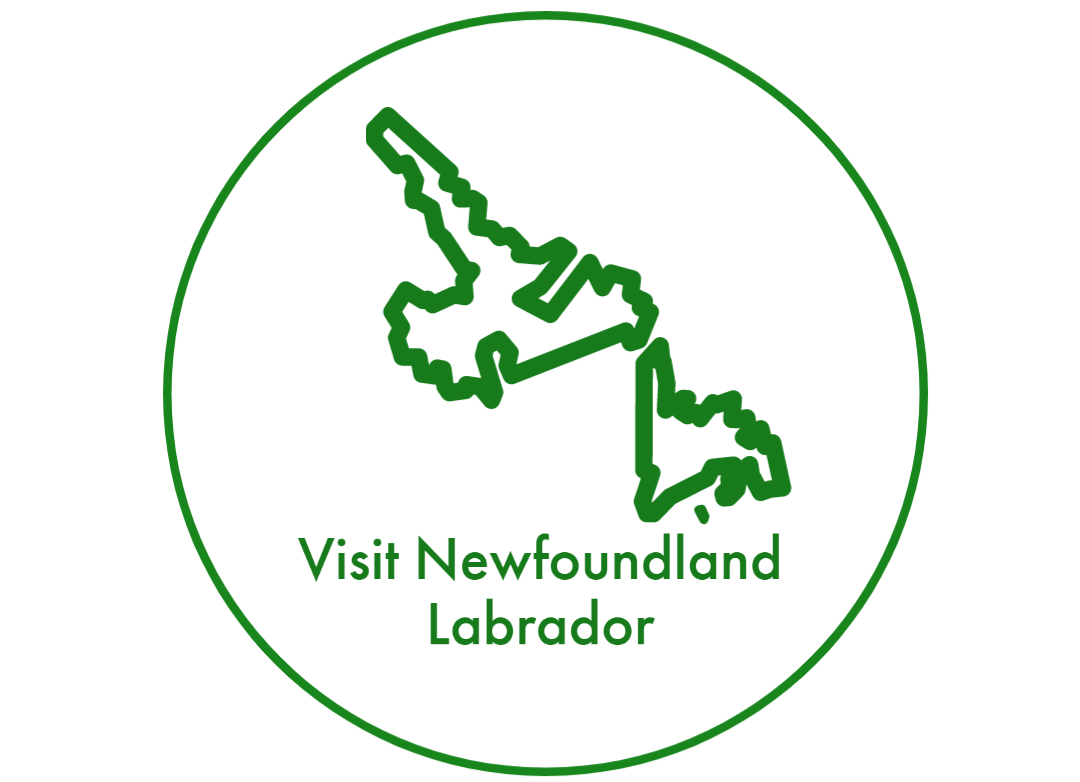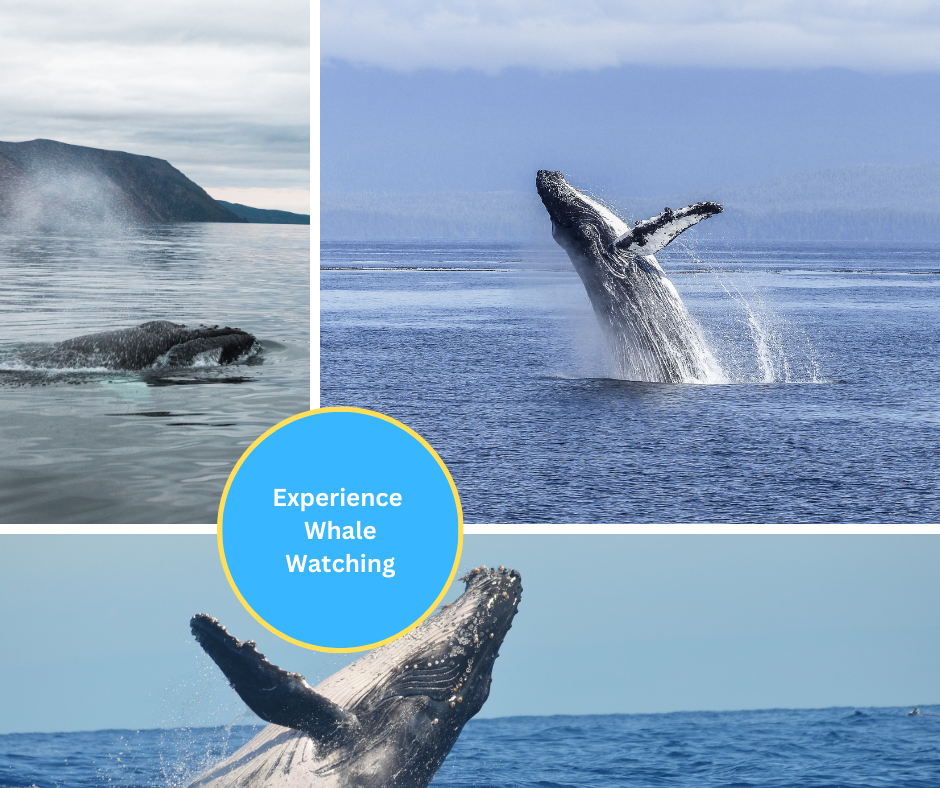How To Best Experience Newfoundland Whale Watching Season
This is how to best experience Newfoundland Whale Watching season. This is a guide to experiencing the thrills of Newfoundland Whale Watching season. We answer some of the top questions that will make your whale-watching trip more enjoyable.
Q: When is the best time to go whale watching in Newfoundland?
A: The best time to go whale watching in Newfoundland is from late May to early September, when the waters are teeming with various species, such as humpback whales, minke whales, and orcas.
Q: Where can I go whale watching in Newfoundland?
A: Newfoundland offers several excellent whale-watching locations, including Battle Harbour, Red Bay, Strait of Belle Isle, Point Amour, St. Anthony, Bonne Bay, White Bay, Twillingate, Cape Bonavista, Trinity, Signal Hill, Witless Bay, Cape Race, St. Vincent’s Beach, and Cape St. Mary’s.These areas are known for their rich marine ecosystems and frequent whale sightings.
Q: What types of whales can I see in Newfoundland?
A: In Newfoundland, you can spot several whale species, including humpback whales, fin whales, minke whales, orcas, and even the occasional blue whale. These magnificent creatures migrate to the area during the summer months.
Q: How long does a typical whale-watching tour in Newfoundland last?
A: A typical whale-watching tour in Newfoundland usually lasts around 2 to 3 hours. This duration allows ample time to explore the coastal waters and increases the chances of encountering whales.
Q: What should I wear for a whale-watching tour in Newfoundland?
A: It’s recommended to dress in layers when going on a whale-watching tour in Newfoundland. The weather can be unpredictable, so wearing warm clothing, a waterproof jacket, comfortable shoes, and a hat is advisable.
Q: Can I bring my camera on a whale-watching tour?
A: Absolutely! Bringing your camera on a whale-watching tour is highly encouraged. You’ll be able to capture breathtaking shots of whales breaching, tail slapping, or even spy-hopping.
More Newfoundland and Labrador Travel Guides
- 30 days travel itinerary that will make you happy
- The Best Things To Do On Bell Island That Will Make You Happy
- The Best Hotels In St. John’s Newfoundland For Your Stay
- Best Things you will love to Do in Gros Morne National Park
- 33 Helpful Tips For Traveling To Newfoundland And Labrador
Q: Are there age restrictions for whale watching in Newfoundland?
A: Most whale-watching operators in Newfoundland welcome participants of all ages. However, checking with the tour operator regarding any age restrictions or recommendations for young children is advisable.
Q: Is it safe to go whale watching in Newfoundland?
A: Yes, whale watching in Newfoundland is generally considered safe. Tour operators prioritize safety and adhere to strict guidelines to ensure passengers have a secure and enjoyable experience on the water.
Q: Can I see icebergs while whale watching in Newfoundland?
A: There is a possibility of seeing icebergs while whale watching in Newfoundland, especially in the early summer months. These massive ice formations create a stunning backdrop and add to the overall experience.
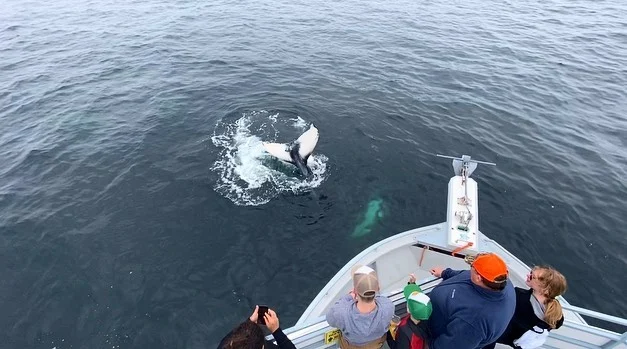
Q: How close can we get to the whales during a tour?
A: While whale-watching tours in Newfoundland adhere to regulations that maintain a safe distance from the whales, you can still get relatively close to these majestic creatures. Depending on their behaviour, whales may approach the boat out of curiosity.
Q: Are there any whale conservation efforts in Newfoundland?
A: Yes, Newfoundland has various whale conservation initiatives in place. These efforts focus on research, education, and implementing responsible whale-watching practices to minimize any potential negative impacts on the marine ecosystem.
Q: Can I book a private whale-watching tour in Newfoundland?
A: Many Newfoundland whale-watching operators offer private tours for individuals or small groups. This option allows for a more personalized experience and flexibility in planning.
Q: Can I see any other wildlife species during a whale-watching tour in Newfoundland?
A: Besides whales, you may encounter other wildlife species, such as seabirds (e.g., puffins, gannets) and marine mammals (e.g., seals, dolphins). The diverse ecosystem in Newfoundland provides a rich habitat for various creatures.
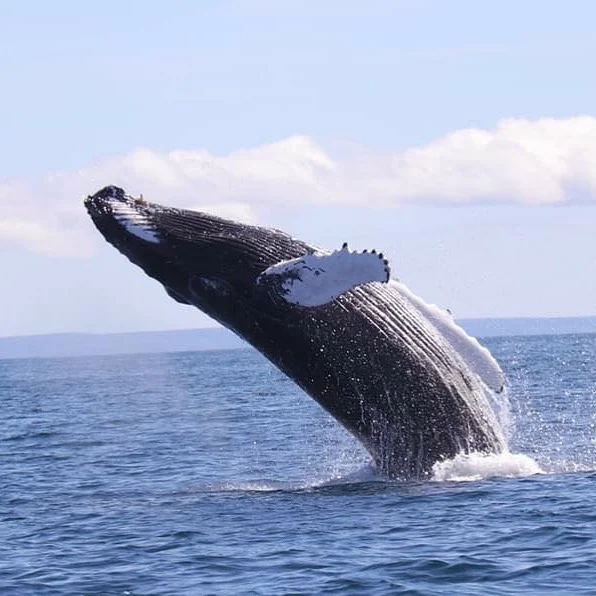
Q: What is the cancellation policy for whale-watching tours in Newfoundland?
A: The cancellation policies for Newfoundland whale-watching tours may vary among operators. It’s important to check the specific terms and conditions when booking. Some operators offer refunds or rescheduling options in case of unfavourable weather conditions or unforeseen circumstances.
Q: Can I go whale watching in Newfoundland if I get seasick quickly?
A: If you’re prone to seasickness, it’s advisable to take precautions before going on a whale-watching tour in Newfoundland. Consider taking motion sickness medication or using alternative remedies recommended by your healthcare professional to minimize discomfort.
Q: How many people are usually on a whale-watching boat in Newfoundland?
A: The number of people on a whale-watching boat in Newfoundland can vary depending on the size of the vessel and the operator’s capacity. It can range from small groups of around 10 to larger boats accommodating 50 or more passengers.
Q: What are the different tour options for whale watching in Newfoundland?
A: Whale-watching tour options in Newfoundland can include zodiac boat tours, more extensive vessel tours, and even kayaking tours. Each option provides a unique perspective and level of adventure, allowing you to choose the experience that suits your preferences.
Q: Are there any restrictions on touching or swimming with whales in Newfoundland?
A: Yes, there are strict regulations in place that prohibit touching or swimming with whales in Newfoundland. These guidelines are designed to protect the whales and maintain a respectful distance between humans and wildlife.
Q: Can I bring food or snacks on a whale-watching tour in Newfoundland?
A: It’s generally acceptable to bring food or snacks on a whale-watching tour in Newfoundland, but it’s recommended to check with the tour operator beforehand. Remember to dispose of any waste properly to minimize environmental impact.
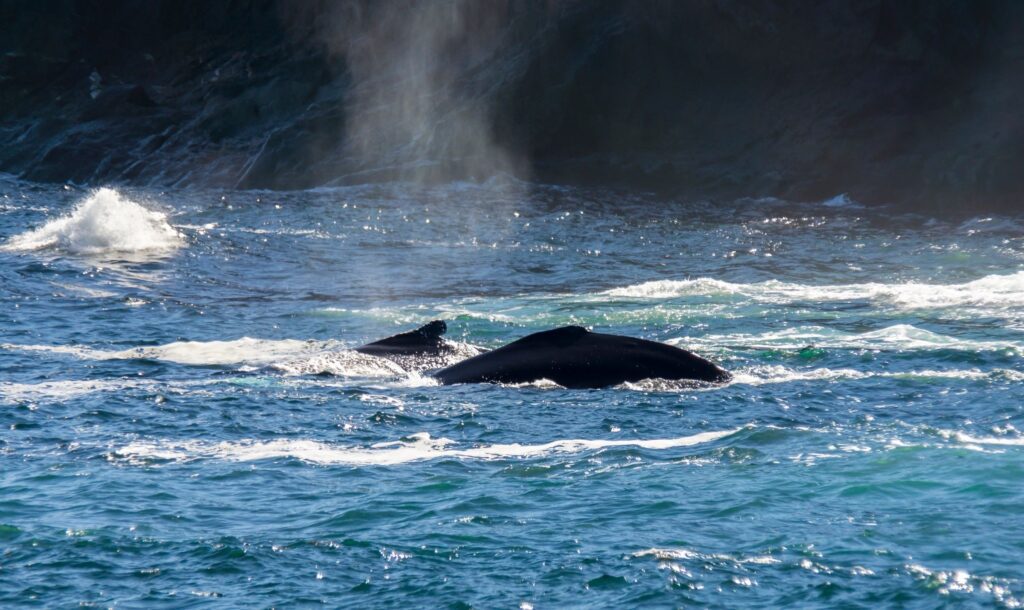
Q: Are there guided tours available for whale watching in Newfoundland?
A: Yes, guided tours are available for whale watching in Newfoundland. Knowledgeable guides accompany the tours, providing valuable insights about the whales, the local marine ecosystem, and the region’s history.
Q: What is the average cost of a whale-watching tour in Newfoundland?
A: The cost of a whale watching tour in Newfoundland can vary depending on factors such as tour duration, vessel type, and additional services included. On average, expect to pay around $80 to $100 per person for a standard tour.
Q: Can I bring a pet on a whale-watching tour in Newfoundland?
A: Generally, pets are not allowed on whale-watching tours in Newfoundland due to safety and logistical reasons. Making suitable arrangements for your pet’s care while you enjoy the tour is recommended.
Q: How do I choose a reputable whale-watching operator in Newfoundland?
A: When selecting a whale-watching operator in Newfoundland, consider their experience, reputation, safety record, customer reviews, and adherence to responsible whale-watching practices. Researching and comparing different operators can help you make an informed choice.
Q: Are there any educational programs or initiatives for children during whale-watching tours in Newfoundland?
A: Some Newfoundland whale-watching operators offer educational programs tailored for children. These programs aim to educate young participants about marine life, conservation, and protecting whales and their habitat.
Q: Can I go whale watching in Newfoundland if I can’t swim?
A: You can still go whale watching in Newfoundland even if you can’t swim. Whale-watching tours are conducted on boats, and participants are not required to enter the water.
Q: Are any discounts or special offers available for whale-watching tours in Newfoundland?
A: Some whale-watching operators in Newfoundland may offer discounts or special offers, especially during off-peak seasons or for group bookings. It’s worth checking the websites or contacting the operators directly to inquire about current promotions or deals.
Q: Can I bring my binoculars for whale watching in Newfoundland?
A: Absolutely! Bringing your binoculars for whale watching in Newfoundland is highly recommended. It allows you to have a closer view of the whales and enhances your overall experience on the tour.
Q: What is the duration of the whale watching season in Newfoundland?
A: The whale watching season in Newfoundland typically spans from May to September. During these months, whales migrate to the area to feed and mate, providing ample opportunities for sightings.
Q: Can I see puffins during a whale-watching tour in Newfoundland?
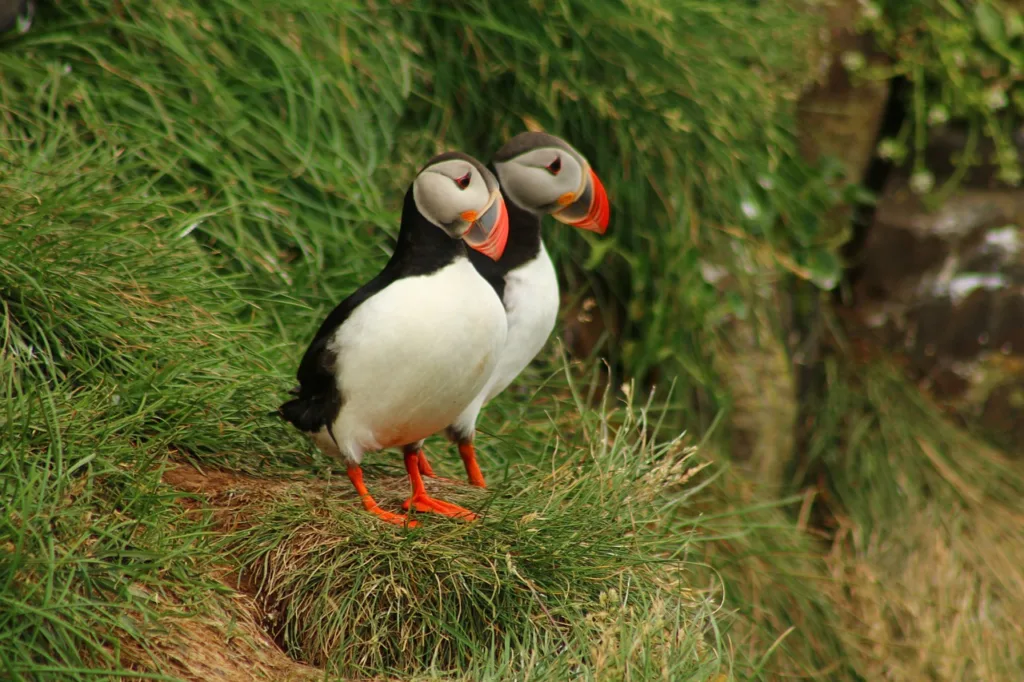
A: It’s possible to see puffins during a whale-watching tour in Newfoundland. The coastal waters are home to numerous seabird colonies, including puffins. Keep an eye out for these adorable and colourful birds during your tour.
Q: Are there any drone use restrictions during whale watching in Newfoundland?
A: Using drones for whale watching in Newfoundland is subject to regulations and restrictions to protect the well-being of the whales and ensure the safety of other tour participants. It’s advisable to check with the operator beforehand regarding their policy on drone usage.
Travelling to Newfoundland and Labrador. Travelers also ask.
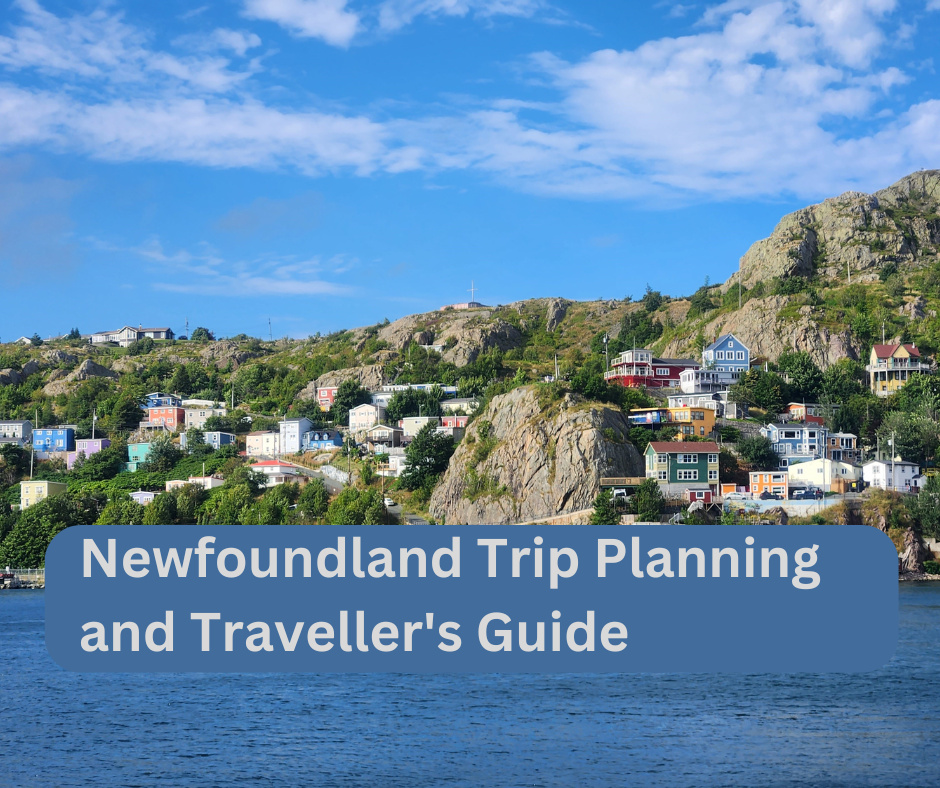
Can you see icebergs in Newfoundland now?
Icebergs are typically seen off the coast of Newfoundland from late spring to early summer. The best months for iceberg viewing are usually May and June. If it’s within this timeframe, you can likely see icebergs, especially in areas like Twillingate and St. Anthony.
When to see icebergs in Twillingate?
The prime time to see icebergs in Twillingate is from late May to early June. This period offers the highest likelihood of witnessing these massive ice formations as they drift southward along the coast.
Where is the best place to see icebergs?
The best places to see icebergs in Newfoundland include Twillingate, St. Anthony, Bonavista, and Fogo Island. Twillingate is often called the “Iceberg Capital of the World” due to its high iceberg count and accessibility.
What is the best month to see icebergs in Newfoundland?
The best month to see icebergs in Newfoundland is May. During this month, the icebergs are plentiful, and the weather is often more favourable for boat tours and coastal viewing.
How long do icebergs last in Newfoundland?
Icebergs can last from a few weeks to several months in Newfoundland waters. Their longevity depends on their size, the water temperature, and the weather conditions. Typically, icebergs seen off Newfoundland begin their journey from Greenland and take about 1-2 years to reach the island.
Where is Newfoundland Iceberg Alley?
Iceberg Alley refers to the stretch of ocean off the coast of Newfoundland and Labrador, where icebergs are commonly seen. It extends from the coast of Labrador down through Newfoundland’s eastern shore, including areas like Twillingate, St. Anthony, and Bonavista.
Are there icebergs in Newfoundland in August?
By August, the number of icebergs in Newfoundland significantly decreases. While it’s possible to see the occasional iceberg, they are much rarer than the peak months of May and June.
What month is the warmest in Newfoundland?
July is typically the warmest month in Newfoundland, with a temperatures ranging from 15°C to 20°C. This makes it a popular time for visitors seeking to explore the island’s natural beauty.
Where to see whales in Newfoundland?
Whale watching is popular in Newfoundland from June to September. The best locations include St. John’s, Trinity, Bonavista, and Witless Bay Ecological Reserve, renowned for its abundant marine life, including humpback whales.
Can you see the Northern Lights from Newfoundland?
You can see the Northern Lights from Newfoundland, particularly in the more northern and remote parts of the island. The best times are during the fall and winter when the nights are the longest and the skies are the darkest.
How close to Newfoundland did the Titanic sink?
The Titanic sank about 370 miles south-southeast off the coast of Newfoundland. The nearest land to the wreck site is the southeastern tip of Newfoundland.
How close is the Titanic to Newfoundland?
The Titanic’s wreck is located approximately 370 miles off the coast of Newfoundland. This proximity made Newfoundland a critical point in the communication and rescue efforts following the disaster.
Where did the Titanic sink off Newfoundland?
The Titanic sank in the Atlantic Ocean, approximately 370 miles south-southeast of Newfoundland coast.
Are there polar bears in Newfoundland?
Polar bears are not native to Newfoundland itself, but they occasionally appear on the northern coast of Labrador, particularly when sea ice drifts south from the Arctic.
What is the iceberg capital of Canada?
Twillingate, a small coastal town in Newfoundland, is known as the “Iceberg Capital of the World” due to its frequent and spectacular iceberg sightings during the peak season.
How fast do icebergs move?
Icebergs generally drift at about 0.7 kilometres per hour (0.4 miles per hour). However, their speed can vary depending on ocean currents, winds, and the iceberg’s size.
Why are icebergs sometimes black?
Icebergs appear black when they contain a high amount of sediment and debris. This can occur when icebergs calve off glaciers that scrape the land, picking up rocks and soil, which then get frozen into the ice.
Does the Atlantic Ocean in Newfoundland freeze?
The Atlantic Ocean around Newfoundland does not freeze over due to its relatively warmer temperatures than Arctic waters. However, sea ice and icebergs from the Arctic can drift into Newfoundland waters, especially during the spring.
Are there puffins in Twillingate?
While puffins are not commonly found in Twillingate, they are prevalent in other parts of Newfoundland, such as the Witless Bay Ecological Reserve. Twillingate is more famous for its iceberg and whale sightings.
What is the best time to see whales in NL Newfoundland?
The best time to see whales in Newfoundland is from June to September. Humpback whales, minke whales, and other species migrate through Newfoundland coastal waters during this period.
Is the tip of the iceberg visible?
Yes, the tip of the iceberg is visible above the water, but it represents only about 10% of its total mass. The remaining 90% is submerged underwater, making icebergs particularly dangerous for ships.
Can you see icebergs in Newfoundland in July?
Yes, you can still see icebergs in July in Newfoundland, although they are less common than in May and June. By July, many icebergs have drifted further south or melted.
Where is the best place to see icebergs?
Twillingate, St. Anthony, Bonavista, and Fogo Island are the best places to see icebergs in Newfoundland. These locations offer optimal viewing points and tour opportunities.
How often can you see northern lights in Newfoundland?
The Northern Lights can be seen in Newfoundland several times a year, especially in the fall and winter months. The frequency depends on solar activity and the clarity of the night skies.
Why is it called Iceberg Alley?
The stretch of water known as Iceberg Alley gets its name from the numerous icebergs that travel through this area each year. The icebergs originate from Greenland and drift down the Labrador Current past Newfoundland and Labrador.
When should I visit Iceberg Alley?
The best time to visit Iceberg Alley is from late May to early June. During this period, the highest concentration of icebergs can be seen, offering the most spectacular views.
Can you swim in Newfoundland in August?
Yes, you can swim in Newfoundland in August, especially in the warmer, sheltered areas like lakes and coves. However, the ocean waters remain pretty cold, typically around 12-15°C, so swimming in the sea can be chilly.
How hot is Newfoundland in July?
Newfoundland experiences its warmest weather in July, with a temperatures ranging from 15°C to 20°C. Some days can be warmer, especially inland and away from the coastal breezes.
What are the top tourist attractions in Bay Bulls and Witless Bay?
Bay Bulls is known for its incredible whale-watching tours, particularly with O’Brien’s Whale and Bird Tours. Witless Bay Ecological Reserve is famous for its puffin colonies and seabird watching. Both areas also offer beautiful coastal hiking trails, such as the East Coast Trail.
Where can I go whale watching in Bay Bulls?
O’Brien’s Whale and Bird Tours is the most popular whale-watching operator in Bay Bulls. Their tours often spot humpback whales, orcas, and other marine life, providing an unforgettable experience.
What wildlife can I see in Witless Bay Ecological Reserve?
The Ecological Reserve in Witless Bay is home to the largest Atlantic puffin colony, common murres, black-legged kittiwakes, and other seabirds on the island. During certain seasons, visitors can also see humpback whales and dolphins.
How do I get to Bay Bulls and Witless Bay from St. John’s?
Bay Bulls and Witless Bay are approximately a 30-minute south of St. John’s. Take the Southern Shore Highway, directly to these coastal towns.
What are the best hiking trails in Bay Bulls?
The Spout Path and Mickeleens Path are part of the East Coast Trail network and are highly recommended for their scenic coastal views, challenging terrain, and natural beauty.
When is the best time to visit Witless Bay to watch puffins?
The best time to see puffins in Witless Bay is mid-May to mid-September. During this period, thousands of puffins nest and raise their young on the Witless Bay Ecological Reserve islands.
Are there any good restaurants in Bay Bulls and Witless Bay?
In Mobile, The Captain’s Table is well-known for its seafood dishes and delicious local cuisine in a cozy atmosphere.
What accommodation options are available in Bay Bulls and Witless Bay?
The area has several charming B&Bs and inns, such as Bread and Cheese Country Inn in Bay Bulls and Whale House Guest House in Witless Bay, offering comfortable stays and local hospitality.
What are some family-friendly activities in Bay Bulls?
Whale watching, visiting the Witless Bay Ecological Reserve, and exploring the scenic trails are great family-friendly activities. Additionally, families can enjoy picnicking, puffin watching and beachcombing along the coast.
Can you swim in the waters around Bay Bulls and Witless Bay?
The waters around Bay Bulls and Witless Bay are generally cold, even in summer, and the rugged coastline can be dangerous for swimming. However, beachcombing and exploring tide pools can be enjoyable activities.
What marine life can be seen on a boat tour from Bay Bulls?
Boat tours from Bay Bulls often encounter humpback whales, orcas, minke whales, and numerous seabirds such as puffins, razorbills, and murres. Occasionally, dolphins and sea turtles are also spotted.
Are there any guided tours in Witless Bay?
Several companies offer guided tours in Witless Bay, focusing on bird watching, whale watching, and exploring the ecological reserve. O’Brien’s Whale and Bird Tours is a notable provider.
What are the best photography spots in Bay Bulls and Witless Bay?
The rugged coastline, picturesque harbour, and wildlife offer excellent photography opportunities. Specific spots include:
- The viewpoints along the East Coast Trail.
- The harbour in Bay Bulls.
- The bird colonies in Witless Bay Ecological Reserve.
What are some nearby attractions to Bay Bulls and Witless Bay?
Nearby attractions include Cape Spear, North America’s easternmost point, and La Manche Provincial Park, known for its suspension bridge and hiking trails. St. John’s has a rich history and vibrant culture.
Is there a visitor center in Bay Bulls or Witless Bay?
While there isn’t a dedicated visitor center, local tour operators and accommodations often provide information and resources for visitors.
What are the best times of year to visit Bay Bulls and Witless Bay for outdoor activities? The summer months (June to September) are ideal for outdoor activities, offering the best weather for hiking, whale watching, and bird watching. Fall also provides beautiful foliage and fewer crowds.
Can you see the Northern Lights in Bay Bulls and Witless Bay?
While it’s not common, on precise nights, particularly in the winter months, it is possible to see the Northern Lights in Bay Bulls and Witless Bay due to their northern latitude and low light pollution.
What types of whales can you see in Bay Bulls and Witless Bay?
In Bay Bulls and Witless Bay, you can commonly see humpback whales, minke whales, and occasionally orcas. The region’s rich marine ecosystem attracts these magnificent creatures, particularly during the summer when they migrate to feed.
When is the best time to watch whales in Bay Bulls and Witless Bay?
The best time for whale watching in Bay Bulls and Witless Bay is from mid-June to mid-August. During these months, the waters teem with whales due to the abundance of capelin, their primary food source.
What is the weather like for whale watching in Bay Bulls and Witless Bay?
The weather during the whale watching season in Bay Bulls and Witless Bay is mild, with temperatures ranging 13°C to 22°C. However, it can be windy and more relaxed on the water, so dressing in layers is advisable.
How long do whale-watching tours last in Bay Bulls and Witless Bay?
Whale-watching tours in Bay Bulls and Witless Bay typically last 2 to 2.5 hours. This duration allows ample time to locate and observe the whales and enjoy the stunning coastal scenery.
Can you see puffins while whale watching in Bay Bulls and Witless Bay?
Absolutely! Puffins are a common sight in Bay Bulls and Witless Bay, especially around the Witless Bay Ecological Reserve, which hosts one of the largest puffin colonies in North America. Many whale-watching tours also include puffin viewing.
What should you wear for whale watching in Bay Bulls and Witless Bay?
For whale watching in Bay Bulls and Witless Bay, wearing layered clothing to adjust to changing temperatures, a waterproof jacket, non-slip shoes, and a hat is best.
Are whale-watching tours in Bay Bulls and Witless Bay family-friendly?
Yes, whale-watching tours in Bay Bulls and Witless Bay are family-friendly. The tours suit children, and the experience can be educational and thrilling for all ages. However, checking with the tour operator for specific age restrictions or recommendations is essential.
How close can you get to whales on a Bay Bulls and Witless Bay tour?
Tour boats maintain a respectful distance from the whales to ensure their safety and comfort. Typically, boats stay at least 200 meters away, but whales often approach boats out of curiosity, offering closer views without disturbance.
What other wildlife can you see while whale watching in Bay Bulls and Witless Bay?
Besides whales and puffins, you might see other seabirds, such as razorbills, murres, and gannets. Seals and dolphins are also frequent visitors to these waters, enhancing the overall wildlife viewing experience.
Do you need to book whale-watching tours in advance in Bay Bulls and Witless Bay?
We recommend booking whale-watching tours in advance, especially during peak season (mid-June to mid-August). This ensures you secure a spot on your preferred tour and time.
What are Bay Bulls and Witless Bay’s best whale-watching tour operators?
Some of the best whale-watching tour operators in Bay Bulls and Witless Bay include O’Brien’s Whale and Bird Tours, Gatherall’s Puffin and Whale Watch, and Mullowney’s Puffin and Whale Tours. These operators are well-reviewed for their knowledgeable guides and excellent service.
How much do whale watching tours cost in Bay Bulls and Witless Bay?
Whale-watching tour prices in Bay Bulls and Witless Bay range from CAD 60 to CAD 120 per adult. Discounts are often available for children, seniors, and group bookings.
Are whale-watching tours in Bay Bulls and Witless Bay accessible for people with disabilities?
Many whale-watching tour operators strive to be inclusive, offering boats with ramps or lifts for wheelchair access. However, contacting the tour operator in advance is advisable to ensure they can accommodate specific accessibility needs.
What safety measures exist for whale-watching tours in Bay Bulls and Witless Bay?
Safety measures include life jackets for all passengers, safety briefings before departure, experienced captains and crew, and adherence to weather advisories. Boats are also equipped with communication devices and emergency equipment.
Can you see whales from the shore in Bay Bulls and Witless Bay?
While spotting whales from the shore in Bay Bulls and Witless Bay is possible, the best views are typically obtained from a boat. However, certain coastal areas and lookout points may offer occasional sightings.
What should you bring on a whale-watching tour in Bay Bulls and Witless Bay?
Bring a camera or binoculars for better viewing, layered clothing, a waterproof jacket, sunscreen, a hat, and any personal items like motion sickness medication.
What is the Witless Bay Ecological Reserve, and why is it essential for whale watching?
The Witless Bay Ecological Reserve is a protected area known for its abundant marine wildlife, including large seabird colonies and frequent whale sightings. Its nutrient-rich waters attract whales, making it a prime location for whale watching.
Are there educational components to whale-watching tours in Bay Bulls and Witless Bay?
Many tours include educational commentary from knowledgeable guides who provide information about whale behaviour, marine ecosystems, and conservation efforts. This enhances the overall experience by adding an educational dimension.
What is the success rate of seeing whales on tours in Bay Bulls and Witless Bay?
The success rate of seeing whales in Bay Bulls and Witless Bay is very high, often exceeding 90% during peak season. The region’s rich feeding grounds and migration patterns ensure frequent sightings.
Thank you for reading.
These are the best travel planning resources you should use.
Looking to book your trip to Newfoundland and Labrador? Use these resources that are tried and tested by other travellers like you who vacation in Newfoundland and Labrador. Bookmark these links. Save them for future reference.
Booking Flights, Hotels or B&B: Start planning your next vacation trip by finding the best flight, hotel or b&b deals. Book Here
Finding things to do in Newfoundland and Labrador on TripAdvisor and Viator is not hard. Enjoy boat tours, whale watching, icebergs watching, kayaking and other activities.
You can also find low prices on hotels, B&B and cabins with these two providers. If you are located in Canada, the USA, the UK or Europe, use Booking.com, and if you are in Canada, the USA or anywhere else, use TripAdvisor.
Car Rental: Here is what we recommend:
When you book with Rentalcars.com, you can compare prices and find the best vehicle for your trip. Economybookings.com Display all their vehicle on the website with a detailed description. They display high-quality photos and a user rating as well. Qeeq.com serves road trip travellers like you from different countries by working with car rental companies worldwide.
Get compensated if your flight is delayed or cancel
AirHelp and Compensateair will help you with flight delays, cancellations, or denied boarding. All you need to do is to submit your flight details, and they will handle the claim process on your behalf. They will handle all the paperwork, airline negotiations, and legal proceedings.
Do you need more help planning your trip?
Check out our Resources Page, where we highlight all the resources and companies you can use to assist with your planning.
